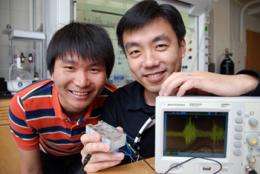Electricity from the nose: Engineers make power from human respiration

(PhysOrg.com) -- The same piezoelectric effect that ignites your gas grill with the push of a button could one day power sensors in your body via the respiration in your nose.
Writing in the September issue of the journal Energy and Environmental Science, Materials Science and Engineering Assistant Professor Xudong Wang, postdoctoral Researcher Chengliang Sun and graduate student Jian Shi report creating a plastic microbelt that vibrates when passed by low-speed airflow such as human respiration.
In certain materials, such as the polyvinylidene fluoride (PVDF) used by Wang’s team, an electric charge accumulates in response to applied mechanical stress. This is known as the piezoelectric effect. The researchers engineered PVDF to generate sufficient electrical energy from respiration to operate small electronic devices.
“Basically, we are harvesting mechanical energy from biological systems. The airflow of normal human respiration is typically below about two meters per second,” says Wang. “We calculated that if we could make this material thin enough, small vibrations could produce a microwatt of electrical energy that could be useful for sensors or other devices implanted in the face.”
Researchers are taking advantage of advances in nanotechnology and miniaturized electronics to develop a host of biomedical devices that could monitor blood glucose for diabetics or keep a pacemaker battery charged so that it would not need replacing. What’s needed to run these tiny devices is a miniscule power supply. Waste energy in the form or blood flow, motion, heat, or in this case respiration, offers a consistent source of power.
Wang’s team used an ion-etching process to carefully thin material while preserving its piezoelectric properties. With improvements, he believes the thickness can be controlled down to the submicron level. Because PVDF is biocompatible, he says the development represents a significant advance toward creating a practical micro-scale device for harvesting energy from respiration.
Provided by University of Wisconsin-Madison


















